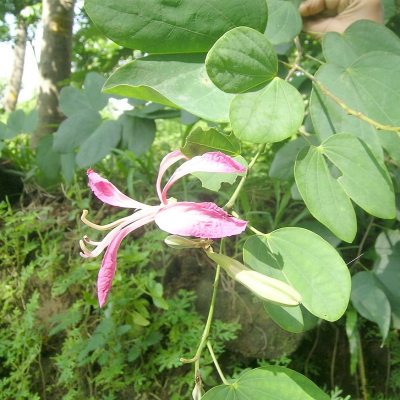Distribution: Sub-Himalayan tracts from the Indus eastwards and throughout the dry forests of India, ascending to 1300 m above MSL. Cultivated throughout the plains.
Botany: Moderate sized deciduous tree with vertically cracked grey bark
- Wood: Moderately hard, greyish brown with irregular darker patches.
- Leaf: 2 leaflets, connate for about two-thirds up. Leaflets are ovate with rounded apex, 10-15 cm long, pubescent beneath when young and coriaceous.
- Flowers: Pink, the uppermost petal darker and variegated usually appearing before the leaves in short axillary or terminal racemes. Stamens are 5 and stamenodes absent.
- Fruits: Fruits are brown, flat, hard, dehiscent pods with 10-15 seeds. 15- 30cm long.
Chemical constituents: Flowers contain flavanoids-kaempferol-3-galactoside & kaempferol -3-rhamnoglucoside. Stem bark yields hentriacontane, octacosanol and stigmasterol. Stem yields β-sitisterol, lupeol and a flavanone glycoside-5, 7-dimethoxy flavanone 4-O-a-L- rhamnopyranoside-b-D-glucopyranoside.
Uses: Used in glandular diseases and as an antidote to poison. The drug is also reported to be useful in dysentery, diarrhoea, piles and worms. Seeds possess human blood agglutinating activity. Stem bark is hypothermic, CNS active and depressant. Bud, flower, leaf and stem bark are antibacterial. Stem possesses juvenoid activity. Bark is alterative, tonic, antileprotic and antirheumatic. Root is carminative and antidote for snakebite.
Agrotechnology
Propagation: By seed. Seeds collected from the dried pods are soaked in water for 12 hours before sowing in seedbeds. At four-leaved stage they are to be transferred to polybags. Two-month-old seedlings from polybags are used for field planting. Pits of size 60 cm cube are to be taken and filled with 10 kg dried cowdung mixed with topsoil and formed into a mound. These seedlings are to be planted at a distance of 6-7.5 m.
Harvesting: The plant flowers on the third year. At the end of tenth year the tree can be cut and wood used for medicinal purposes.

